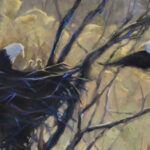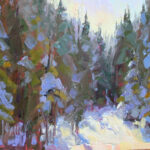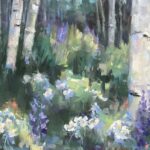
Snowpack Release 2019
There are many characters populating my Colorado world; family, friends, wildlife. They each evoke endless challenges and beautiful opportunities. Early yesterday morning a singular doe and I locked gazes at one and other. My look, a focused beam, is predator behavior in her world. I wondered if the doe assumed that was my intent. My stare brought me deep calm as she posed among the aspen trees. I sent prayers of thanks for her appearance. How easily we mammals are convinced of our frailty, freezing in fear. My doe did not startle though, as I moved quietly along. After moments that stretched, she slowly retreated into the brush. If only time would always pass so peacefully.
No character, though, dominates daily living more startlingly than Mother Nature. That great presence can wash a soul gently with wildflower drifts across an alpine meadow, after chilling to the core only months earlier with a passing polar vortex. She demands respect and attention beyond any creature roaming through my aspen laced neighborhood.
High Country Colorado is especially defined by Mother Nature’s cycle. Years are counted by seasons of which there are only two and a half, winter, summer and a blink called autumn. Winter is long, summer is notable, fall swift. There is mud season, not really a season at all, just a few weeks of muck. Except this year.
The snowpack and avalanche debris of 2019 are hanging on beyond any definition of normal. Yes, a few years back there was severe flooding when healthy amounts of snow came down unusually fast due to quickly rising temperatures. Even a couple years ago, the snowpack was significant, 200% of normal. Calculation, speculation and planning swirled amongst the learned and wise as resident experts debated the runoff back then.
This year has a completely different, sharper tone. The snow was extraordinary this year. Epic, as the hipster’s would say. The avalanches, fueled by massive chaotic layering of snow, were more frequent, powerful and widespread than in recorded history.
Snow is usually a beautiful thing to me. In the dry climate of Colorado, the flakes fall light, delicately fluffy, in what skiers refer to as “champagne powder”, perfectly described. Effervescent blankets are so light at 6” deep they can be blown off a windshield with your breath. In California the snow is different. Deep snow is called “Sierra cement”. Another standard phrase never bettered. In sun or moonshine, white drifts are gorgeously luminous. But lay down light, dry, creamy powder then cover it with heavy wet or melted snow again and again, and you have a volatile stack of winter destruction waiting to happen.
I noticed this tenuous layering as I shoveled snow in early February. Snow plows pile excess snow removed from roads and driveways into large mounds. With each storm they slice through the same path exposing old piled snow like a 7 layer cake. In February, the built up “cake walls” next to my driveway were nearly 5 feet high in places. I could insert my hands into soft low layers, scooping handfuls of champagne powder out from under the next ice hard layers. As winter progressed, the weather continued to worsen with warm to cold, soft over thick, inches to feet of snow over the next months. Yes, months.
Roads and ski areas were closed off and on as massive mantles of heavier snow skidded over air-filled layers, plummeting down new and old mountain chutes. Trees were snapped in half in places never before experiencing avalanches. Some avalanches were set off with well-planned charges to keep skiers and travelers safe. Others were an unfortunate surprise. And people died in the worst avalanches on record.
Yet the snow kept falling.
Ski areas normally closing in April remained open until mid-June. Some are still operating. Final count on the snow pack of 2019 – 500%+ above average statewide, 400%+ in Summit/Eagle Counties, 700%+ in the southwestern part of the state.
Now the rains have hit. Temperatures are rising slowly. The runoff is coming.
After a failed attempt at fishing due to cold temps and drizzle a few days back on the lower Poudre Canyon, I headed up towards Cameron Pass traveling back to Summit. Sunshine breaks through the clouds occasionally reflecting harshly on the wet pavement. Cache la Poudre does not disappoint. She crashes through the narrows pounding car size boulders spilling down v-shaped gaps throwing blasts of spray along the way. The aspen trees lining the pass are vivid lime green, the color of bloom-time.
In places, the rock canyon walls pull back and meadows appear, lovely velvet from bountiful moisture, the Poudre splashing through. Climbing to the top of the pass, the clouds darken again, the black spires of Nokhu Crags appear, drizzled with snow. Those haunting spikes are surrounded by a chorus of peaks, Braddock, Diamond and Static and Mt. Mahler. She is Nature, hear her roar.
The road descends from alpine forests onto rounded sage covered hills. Tucked between dusty green shrubs, robust lupine clusters glow unearthly blue-purple. Pulling over, next to a small grove of aspen, the lupine mass into cushions of color tucked beneath. I prayed hard to see such sights on this trip. Signs reading “Ranch for Sale” press on my heart and better judgement. A brief but powerful image of cowboy boots, a saddled quarter horse, my Bailey wide brim hat dipping down, an oiled duster flash through my gaga brain.
When my sanity returns, I find I am heading toward Walden. A vast basin on the left, Arapahoe National Wildlife Preserve glows from stuggling sunshine. Ponds and veined tributaries twist their way through the verdant riparian expanse, a high country version of desert oasis.
Taking the longer, less travelled route toward Willow Creek Pass, I scan the surrounding mountain ranges; Never Summer, Medicine Bow and Rabbit Ears. All are capped in snow, engulfed in weather, big and blustery. This is North Park. Thirty miles wide, 45 miles long, with less than a handful of other travelers during the entire crossing. Not a tree in sight. The western side of Rocky Mountain NP slides by to my left as a half a dozen rain showers plunge down in a 180 degree visual drama.
All I kept thinking is “Lord, there is so much snow”. The rain spits and then unleashes a deluge. The rivers are all meeting their banks, ponds full, and the mountains pregnant with a motherlode of white spike in the distance.
There is a system of dams and reservoirs across Colorado and the West. They were built initially with pride and enthusiasm to capture precious waters bringing life to semi-arid/arid ranches and communities. Today the thinking is different, sighting further. Dam proposals consistently are opposed by environmental groups. Water is the new gold rush and worth fighting about, so little for too many characters. All’s quiet in that fight club this year though. No heated dialog in this bumper crop year set to over-serve river systems already glutinously full. I wonder if a little splash will even make it to Mexico this year.
The local media is issuing hopeful reports of the “no flooding yet” flavor. Government officials are releasing massive amounts of water, intentionally keeping reservoirs low in anticipation of the impending runoff. It is only Mother Nature who knows how it will flow this year. The pace of the runoff is a function of temperatures. If it remains cool, perhaps the humans in charge can stay ahead of dam levels and release rates. Higher temps or unexpected rain levels will bring it in much too fast.
This wet cool year kept that doe down low in my little corner of heaven. Witnessing the glory across Northern Colorado was also a gift. Mother Nature gives, surprises, terrifies and teaches. There is snow forecasted this weekend. Go figure. Eyes wide open, muddy boots strapped on, I’m grateful for it all.









